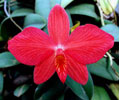|
|
|
|
|
| |
Flasks of
Sophronitis brevipedunculata 'Rassmann' -spontaneous |
|
| |
|
|
| |
| Number: |
TN1232 |
| Name: |
Sophronitis brevipedunculata 'Rassmann' -spontaneous
|
| Type: |
spontaneous (What's that?) |
|
Seed Donor: |
Dale Borders
|
|
Click to Enlarge

Pod Parent Flower |
|
|
|
| |
Culture Notes from Donor: Parent plant: Temperature range I (60-83°F)
For additional origin/habitat information supplied courtesy of
Charles and Margaret Baker, see further below, near the bottom of this page.
|
Temperatures we attempt to use in the lab & greenhouse:
| For Species: |
|
Spring, Summer, Autumn: days average 74°F, nights 57°F; best fit is Cool-Intermediate 75-58°F
(Source:
Baker's Web OSC) |
| For Species: |
|
Winter: days average 67°F, nights 46°F; best fit is Cool-Cold 64-44°F
(Source:
Baker's Web OSC) |
|
About the name...
| Etymology of |
sophronitis |
|
From latinized Greek "sophros" modest.
(Source:
Mayr & Schmucker 1998) |
| Pronunciation of |
sophronitis |
|
sof-row-NYE-tis
(Source:
Hawkes 1978) |
|
If you would like to direct someone to this web page, please copy and paste this URL into your email:
http://troymeyers.com/d?011232
| Flask Information |
| Availability: |
There were problems with this item and we weren't able to make any viable flasks. |
| You should: |
Consider placing a "Notify Retries" Request, and if an identical pollination (the same parents) is done again, we'll let you know. |
|
You might also want to:
|
View the seed assay for this item.
View items of the same species.
View items of the same genus.
|
|
|
| |
The origin/habitat information below is supplied courtesy of Charles and Margaret Baker
The following information is based on the name of the plant provided by the donor, and assumes that the name is correct. If the plant has been misidentified, then the following information may not be correct.
This text is copyrighted by the Bakers and may not be reproduced without permission.
ORIGIN/HABITAT: Brazil. These plants are found in southeastern part of the
state of Minas Gerais from the Serra do Espinhaco in the west to Caparao
in the east. They generally grow on Vellozia bushes, a plant distantly
related to Yucca, that are situated on the saddles between river valleys
from 4500–6000 ft. (1350–1830 m) but may sometimes also be found on rocks.
The habitat is located in a region so dry that conventional trees are
found only in gullies, and the host Vellosia bushes are surrounded by
cacti and other thorny, dryland vegetation. During the evening hours
through most of the year, however, moisture-laden air being lifted over
the ridges and through the saddles where these plants are found condenses
and forms caps of cloud and mist that bathe plants growing there. Visitors
to the habitat report that the fibrous covering on the branches and trunks
of the Vellosia bushes is particularly effective at collecting and holding
available moisture. Thus, even during the dry season, plants growing on
these bushes have a reliable source of moisture.
More about this information and the Bakers...
|
|
|
| |
|
|
|